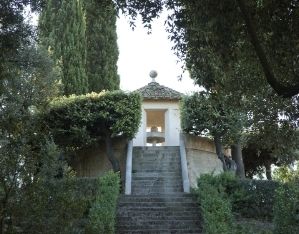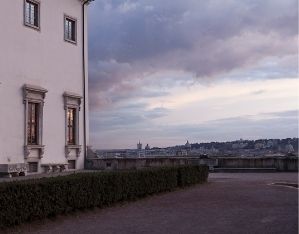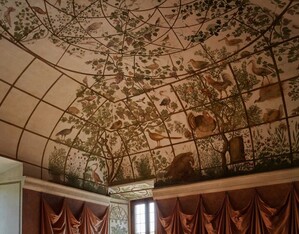On the Pincian hill, in a garden hidden by an austere building, the tradition of the Medici villas combines with the Roman cult for antiquity. The harmonious Renaissance architecture is reflected in the clean layout of the formal garden transitioning into wild thickets.
In 1574 the powerful Cardinal Ferdinando di Medici bought from Cardinal Ricci di Montepulciano an uncompleted villa located on Rome’s most popular hill, already famous in the Roman era and home to many pleasure palaces affording magnificent views of the city. His dream was interrupted by his return to Florence due to dynastic reasons, but not before one building, by architect Bartolomeo Ammannati, was completed. This construction faces the city with a compact and austere prospect. The back facade, however, is decorated with ancient reliefs and features loggias and porticos opening on a garden set out in three sectors with an ample parterre of geometric flowerbeds, bordered with boxwood, once intended for exquisite flowers surrounding a fountain with an obelisk at the centre. Left of the parterre there are the “quadrati”, square green rooms closed by tall hedges, often bordered with ancient herms; on the opposite side grows a wild thicket, a holm oak wood where originally there had been a ragnaia, a system of nets for catching birds. In the direction of Via Pinciana, the thicket transitions into an artificial hill inspired by Mount Parnassus. Valuable, ancient statues lovingly collected by the cardinal used to adorn the garden; among them was the famous group of Niobids and the Dacian prisoners. The entire collection followed the Cardinal on his return to Florence in 1587, and can be seen in the city’s museums. Only a few copies remain in the gardens of Villa Medici.
Highlights

Mount Parnassus
This small, artificial hill at the edge of the park was inspired by Mount Parnassus, sacred to Apollo and the Muses, and is a frequent feature in Renaissance gardens. Built on the remains of a Roman temple dedicated to the Sun it has a steep, straight flight of steps leading to the top. The hill is covered with concentric circles of numerous holm oaks.

The view
One of the best views of Rome can be enjoyed from Villa Medici. The residential area on one side, and the contrasting green of the Janiculum on the other, dominated by the statue of Giuseppe Garibaldi and by another famous Renaissance residence, Villa Lante.

The Studiolo
A small pavilion at the edge of the park, almost suspended on the Aurelian Walls, contains a painted aviary by painter Jacopo Zucchi: amongst the false trellises covered in flowers, many of which are rare species originally from the Americas, various different birds can be spotted including a turkey, which had also been recently imported from America.
 Villa Medici
Contacts
Villa Medici
Contacts
 Villa Medici
Opening times and prices
Villa Medici
Opening times and prices
Opening hours
Guided tours of the Villa Medici gardens are scheduled starting Wednesday, September 16, 2020:
- Monday to Sunday (closed on Tuesday)
- guided tour in Italian: 3.30 pm, 6.00 pm
- guided tour in French: 10.00 am, 2.00 pm, 4.30 pm
- guided tour in English: 3.00 pm
Duration of the visit: 1 h 30′
Pricing
Entrance fee for guided tour of the Villa Medici gardens: € 12.00
Reduced entrance fee for guided tour of Villa Medici gardens: € 6,00
- visitors under 25 years old
- students
- visitors over 60
- unemployed
- teachers of art history
- scholars and members of other foreign academies and institutes in Rome
- FAI members
- Roma Pass, Metrebus, La Feltrinelli Plus Card, Bibliocard, RomaeuropaCard, OperaCard or ArionCard card holders
Gratuity:
- children under 10 years
- disabled persons or war victims with one accompanying person per person, on presentation of a disability card
- journalists with press ID
- holders of an ICOM or ICOMOS card
- staff of the French Ministry of Culture
Tickets booked online must be collected at the ticket desk at Villa Medici.
Free tickets, however, cannot be booked online.
 Villa Medici
How to get there
Villa Medici
How to get there
Address
Viale Trinità dei Monti, 1
00187, Roma (RM)
Latitude: 41.908357
Longitude: 12.482579
How to arrive by bus
Minibus no. 119. Get off at the Trinità dei Monti stop.
Additional directions
By subway
- Metro A: stop at Spagna; go up the Spanish Steps (also with elevator) or take Via di San Sebastianello to Viale Trinità dei Monti (street level of Villa Borghese and Villa Medici).
 Villa Medici
Services/Accessibility
Villa Medici
Services/Accessibility
Services
Villa Medici offers the possibility to stay in its spaces. Rooms can be booked no more than four months in advance.
- Reservations can be made from Monday to Friday (from 9.30 am to 3.30 pm) by e-mail, indicating the type of room (historical or classic) and the dates for which you wish to book.
Guided tours for families
- Visit to the gardens for families with children aged 6 to 10. The duration of the visit is 2 hours
- Sundays at 10.30 a.m.
- advance booking required
- fare : € 6,00 per participant (adult or child) online ticket sales
- The date and time are to be agreed with the Villa Medici group management service.
- The duration of the visit is 1 h 30'.
- tariff: € 1,00 per child
- advance booking required
- The Academy of France in Rome - Villa Medici offers the Promenade Médicis, a formula of exclusive private visit followed by a cocktail, which can be organized outside the opening hours of Villa Medici.
- For groups of more than 150 people, it is also possible to organise a private tour without cocktails for € 35.00 per person.
- External public pay parking accessible only for holders of a permit for the limited traffic zone (ZTL).
- A long-stay car park is accessible from Via Ludovisi (Parking Ludovisi: phone +39 06 47 40 633. Open every day from 5.30 am to 1.30 am).
- Free visits are not currently allowed. Only visits accompanied by guides from the Academy of France in Rome can be booked at the times indicated.
- Tickets can be purchased on site a few minutes before each visit, or online.
- Advance booking on online ticketing is not compulsory but is strongly recommended, and tickets can be collected at the Villa Medici desk a few minutes before visiting time.
- Prior to the visit, it is mandatory to complete and submit the form of prevention Covid-19.
 Villa Medici
Private events
Villa Medici
Private events
 Villa Medici
Itineraries
Villa Medici
Itineraries
You could find the garden in these itineraries
 Favorite saving result
Favorite saving result
 Warning!
Warning!
You've have to sign up or sign in to add this element to your favorites.
